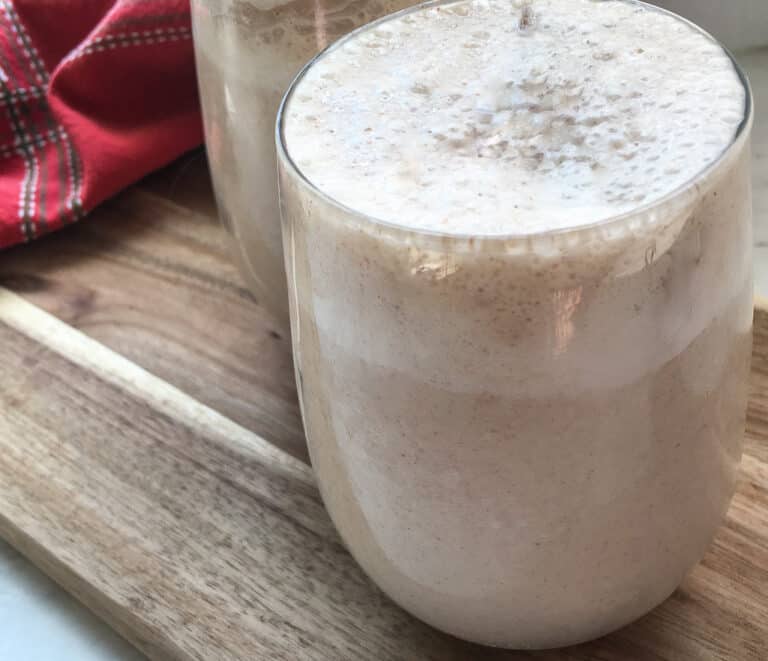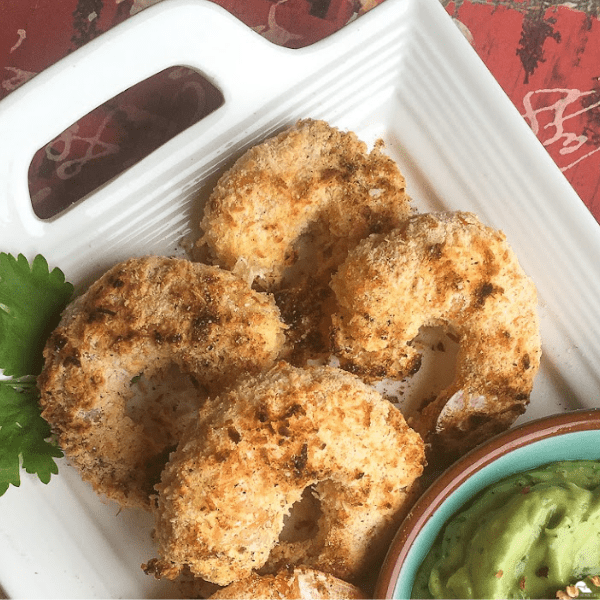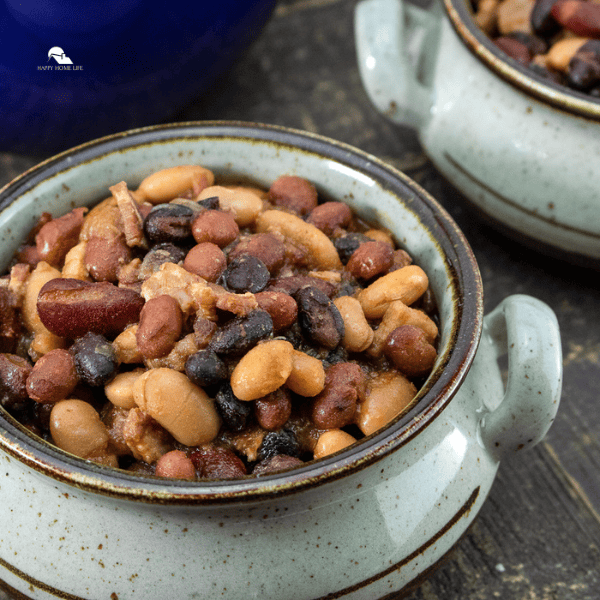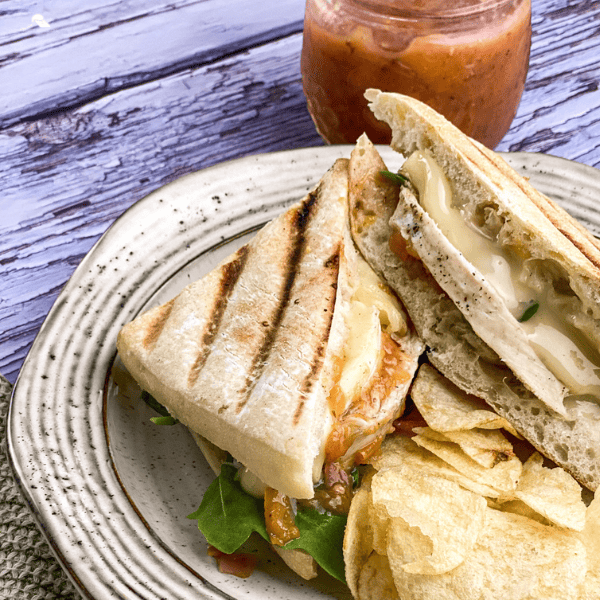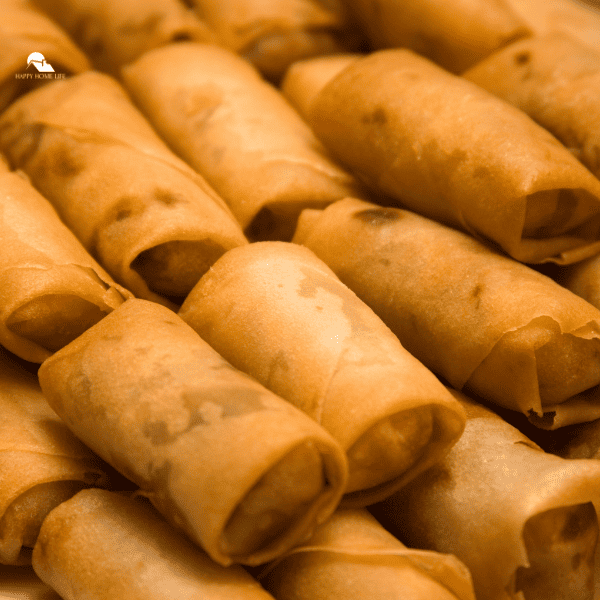Savor the delectable flavors of Mustard Pork Loin with Thyme-Roasted Carrots, a culinary delight perfect for any occasion. This mouth-watering dish combines succulent pork loin coated in a tangy mustard sauce with sweet, thyme-infused roasted carrots. It’s not just a feast for the taste buds but also a healthy, balanced meal.
Whether looking for a comforting weeknight dinner or an impressive dish for special guests, this recipe promises a symphony of flavors. Read on to discover more about this tantalizing pairing, its key ingredients, and how to prepare it perfectly.
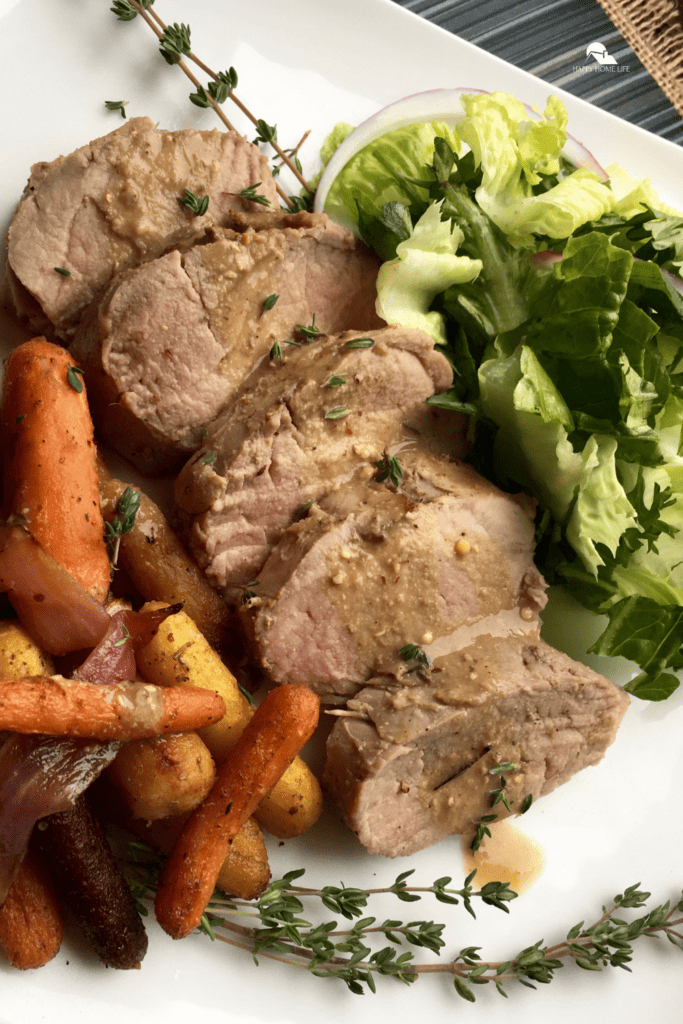
Does pork loin need to be seared?
A pork loin is recommended as it helps lock in the juices and gives the meat a nice brown crust. Searing is a process where you cook the pork loin quickly at a high temperature until it gets a caramelized crust.
This crust not only adds flavor but also improves the appearance of the finished dish. However, it’s not an absolute necessity. If you’re short on time or prefer not to sear, you can roast or cook your pork loin without searing it first. The key to a juicy and flavorful pork loin is not to overcook it, regardless of whether you sear it.
What is the difference between pork loin and pork tenderloin?
Pork loin and pork tenderloin are two different cuts of meat that come from different parts of the pig and have distinct characteristics:
Pork Loin: This cut comes from the back of the pig, between the shoulder and the beginning of the leg. It’s a large, wide cut of meat that can be sold with the bone in or boneless. Pork loin is typically roasted and is known for its rich flavor. It’s also the cut used to make pork chops.
Pork Tenderloin: This cut is a long, narrow piece of muscle that runs along the backbone. It’s one of the most tender cuts of pork, hence the name. It’s typically sold as a small roast and is often prepared by roasting or grilling.
Regarding cooking, pork loin is best when cooked slowly at a low temperature, while pork tenderloin can be cooked quickly over high heat.
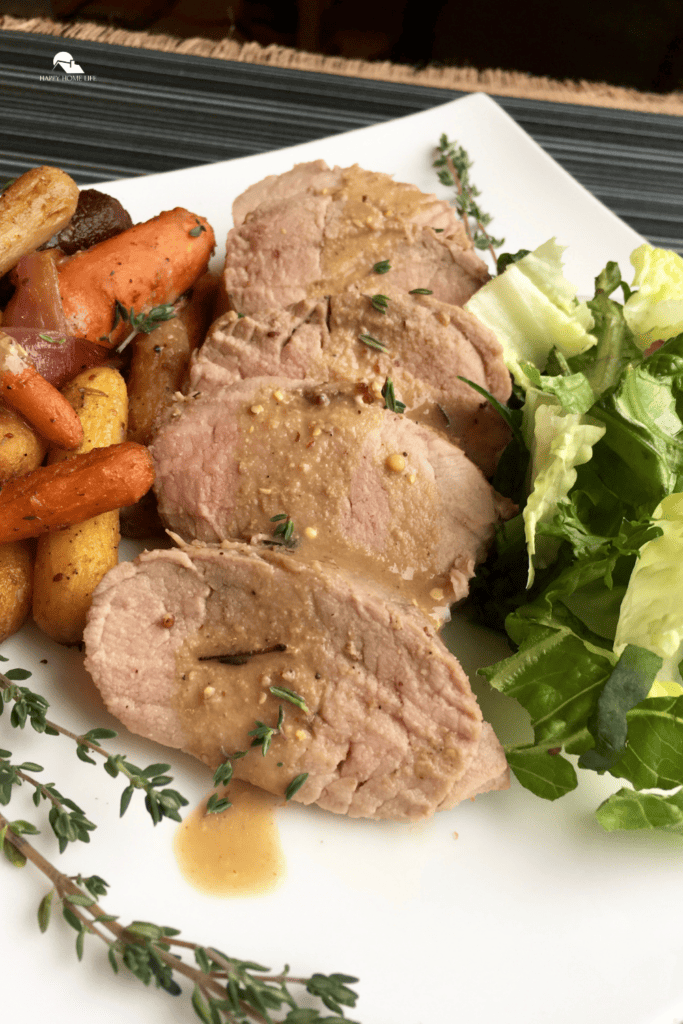
What Makes Mustard Pork Loin Stand Out?
Mustard Pork Loin stands out due to its unique blend of flavors and textures. The key element that makes this dish special is the mustard, which adds a tangy, savory flavor that beautifully complements the rich, tender pork loin.
Different variations of the dish use different types of mustard, from Dijon to whole grain, each contributing its own distinct flavor profile. Some recipes also include additional ingredients in the marinade or glaze, such as brown sugar, rosemary, sherry, garlic, and even Cognac. These elements infuse the pork with even more depth of flavor.
Moreover, the method of cooking, particularly searing and roasting, enhances the taste and texture of the pork. The searing process gives the pork a caramelized crust which not only adds flavor but also improves the appearance of the finished dish. Roasting the pork loin allows it to cook evenly, resulting in moist and tender meat.
Finally, the versatility of mustard pork loin also makes it stand out. It’s easy enough for weeknight dinners yet special enough for holidays or dinner parties. It can be paired with various sides, from braised spinach to thyme-roasted carrots, making it a versatile main course.
What are the ingredients to make Mustard Pork Loin with Thyme-Roasted Carrots?
This recipe can be prepared in 10 minutes and cook this for 40 minutes. Here are the ingredients for 4 to 6 servings:
- Pork loin: The main ingredient.
- Dijon mustard: Used as a marinade, infusing the pork loin with tangy, spicy flavors that balance the sweetness of the roasted carrots.
- Sugar-free whole grain mustard: Adds a bold, tangy flavor to the pork loin. Its grainy texture also gives a pleasant crunch to each bite.
- Virgin olive oil: Helps bind the mustard marinade, aids in roasting the pork to a golden finish, and enhances overall flavor.
- Salt and pepper, to taste: Enhance the dish’s flavors.
- Tri-color baby carrots: Add a vibrant visual appeal to the dish.
- Garlic cloves: Impart a rich, aromatic flavor that complements the savory pork and sweet carrots.
- Balsamic vinegar: Adds a tangy sweetness that balances the savory pork.
- Coconut oil: Used for roasting. It imparts a subtle sweetness and tropical flavor, while also ensuring the meat and vegetables cook evenly and brown beautifully.
- Fresh thyme leaves: Add a subtle, earthy flavor. They enhance the dish’s overall taste profile and beautifully complement the carrots’ natural sweetness.
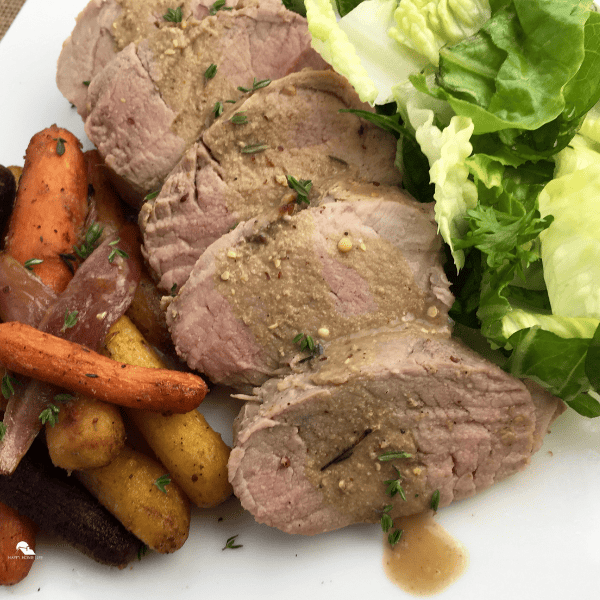
How to make Mustard Pork Loin with Thyme-Roasted Carrots?
It’s time to put this recipe together now that you’ve gathered all of your ingredients.
- Start by preheating your oven to 400 degrees F and lining a baking sheet with parchment paper. Place your pork loin in the center.
- Next, create a mix of Dijon and whole-grain mustard with olive oil in a bowl. Rub this onto the pork and season it with salt and pepper.
- In another bowl, combine baby carrots with garlic, balsamic vinegar, coconut oil, and thyme. Season as required and toss them together. Then, arrange these carrots around the pork on the baking sheet.
- Bake everything for 20 minutes, then flip the pork and bake for another 15-20 minutes until the pork is medium-rare and the carrots are caramelized.
- Let the pork rest for 3-5 minutes before slicing. Serve it warm with the roasted carrots and enjoy!
Can You Make This Dish Ahead of Time?
You can prepare Mustard Pork Loin with Thyme-Roasted Carrots ahead of time. You can marinate the pork loin in the mustard mixture and refrigerate it for up to 24 hours before you plan to cook it. The flavors from the marinade will permeate the meat, making it more flavorful.
As for the thyme-roasted carrots, you can peel and cut them ahead of time, then store them in an airtight container in the refrigerator. When you’re ready to cook, simply toss them in oil and thyme and roast them in the oven.
Please note that the actual cooking of the pork loin and roasting of the carrots should ideally be done shortly before serving to ensure the best taste and texture.
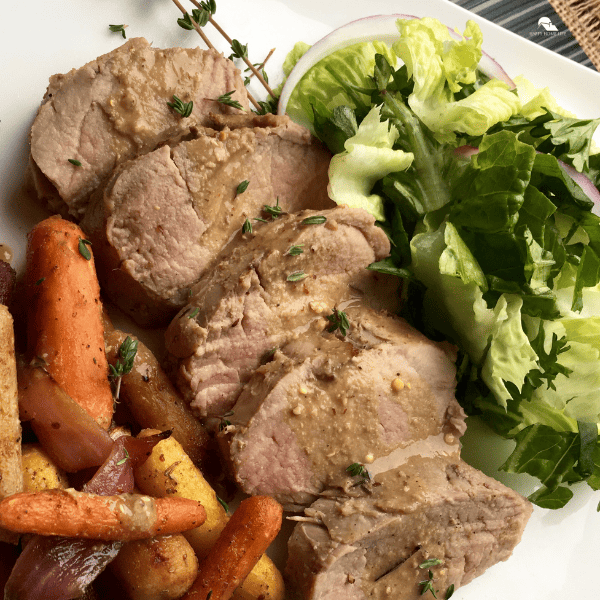
Now that you know all you need to know about Mustard Pork Loin with Thyme-Roasted Carrots it is time to print or save the recipe with the exact measurements.
Not ready to print? No problem! Save this pin in your Pinterest account by clicking the pin button located in the recipe card.
Mustard Pork Loin with Thyme-Roasted Carrots
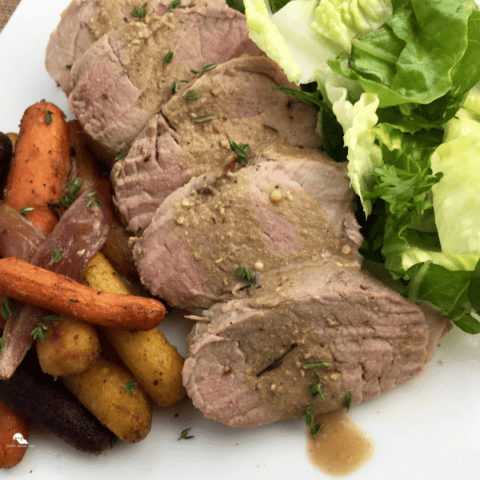
Savor the delightful pairing of Mustard Pork Loin with Thyme-Roasted Carrots. This dish charms with the tanginess of the mustard pork loin, perfectly balanced by the sweetness of the thyme-roasted carrots.
Ingredients
- 2 lbs. pounds pork loin
- 2 T. Dijon mustard
- 2 T. sugar-free whole grain mustard
Instructions
- Preheat your oven to 400 degrees F and line a large, rimmed baking sheet with a piece of parchment paper. Place the pork loin in the center of the lined baking sheet and set aside.
- In a small glass or other non-reactive bowl, combine the Dijon and whole-grain mustard with the olive oil. Massage the pork loin with the mustard mixture, then sprinkle both sides with salt and pepper, to taste. Place the baby carrots in a large bowl and add the garlic, balsamic vinegar, coconut oil, and fresh thyme. Season with salt and pepper, to taste, and toss to combine.
- Spread the carrots in a single layer around the seasoned pork tenderloin on the baking sheet and pour any remaining juices from the bowl on top.
- Cook for 20 minutes, then remove the baking sheet from the oven and flip the pork. Cook for another 15-20 minutes, or until the pork reaches an internal temperature of at least 145° for medium-rare and the carrots are nicely caramelized. Remove from oven and let pork loin rest for 3-5 minutes before slicing. Serve warm with roasted baby carrots. Enjoy!
Nutrition Information:
Yield:
6Serving Size:
1Amount Per Serving: Calories: 310Total Fat: 14gSaturated Fat: 4gTrans Fat: 0gUnsaturated Fat: 7gCholesterol: 121mgSodium: 214mgCarbohydrates: 5gFiber: 0gSugar: 4gProtein: 40g
These nutritional calculations might not be accurate. Please speak with a licensed nutritionist to assist you.

